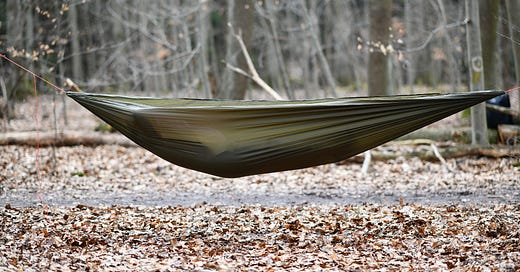Do not disturb, do not destroy
What friluftsliv can teach us about sustainability and living simply
It had been another week of apocalyptic news. In California, entire neighborhoods were obliterated by unprecedented wildfires. In the ocean, researchers found that common seafood was riddled with microplastics. And, to top it off, reports confirmed that last year was the hottest on record – again – marking the first time the global average temperature exceeded the critical 1.5°C threshold above pre-industrial levels. So, I did what I often do when the world seems too much—I packed my hammock and sleeping bag and took off into the woods.
It was a Monday, pitch dark, with the rain coming at me sideways. Not exactly the conditions that make most people think that going camping sounds like a jolly good time. But my need to get away from it all was stronger than my reservations about the weather, or the fact that I’d have to drag myself to work the next day. It was just another day of friluftsliv—the Nordic philosophy of open-air life that has been a part of my identity since childhood.
In a way, friluftsliv has always been about getting away from something. In the mid-1800s, when Norwegian playwright Henrik Ibsen first coined the term, it was a reaction against urbanization and industrialization. People felt a need to escape the crowded and polluted cities for the pristine countryside, where they could breathe fresh air, enjoy nature and reconnect with the rural lifestyle they had lost. Today, friluftsliv also offers a break from the incessant pinging of our cell phones, endless to-do-lists and the 24-hour news cycle.
Simplicity and slow nature
But friluftsliv isn’t just about leaving something behind—it’s about going somewhere and coming home. Home to nature, where humanity has evolved over millennia. As I write in my book, The Open-Air Life, “In essence, traditional friluftsliv is less a set of activities and more of a culturally learned rhythm that revolves around being outside and experiencing oneness with both nature and the cultural landscape. Just like there is slow food, slow parenting, and slow entertainment, friluftsliv is a form of slow nature. It’s about embracing simplicity, resisting consumerism, and living in a way that is sustainable to both ourselves and the planet. It’s the kind of life that transcends generations and connects us deeply with the land that sustains us. And it is in every respect a rich life.”
The idea of friluftsliv carrying a deeper environmental ethos was popularized by the Norwegian philosopher Arne Næss’ deep ecology movement in the 1970s. Deep ecologists criticize human supremacy and overexploitation of the Earth’s resources, favoring an eco-centric view of the world, rather than a human centered. It sees humans as an integral part of nature, where the survival of any one species or ecosystem depends on the well-being of the whole.
While we’re wreaking havoc with the planet today, deep ecologists argue that human societies are not inherently destructive. If in doubt, just look at the indigenous cultures that have lived in harmony with the Earth for millennia. What we need is a fundamental shift in perspective.
Overconsumption by default
The golden rule of friluftsliv, taught to all young children in Sweden, is simple: Do not disturb, do not destroy. In a natural area, it’s pretty straightforward—don’t whack down live trees to build a campfire or poke around in a nest where a bird has just laid their eggs. By adopting a friluftsliv mindset, we can be guided by that simple idea also in everyday life, not just when we’re camping in the countryside or paddling down a river in the remote wilderness. To do so, we must become more aware of our footprint.
The truth is, most of us living in the Western world are overconsuming by default, even the most avid nature lovers. (According to the Global Footprint Network, if everyone lived like an American, we would need 5.1 Earths to meet everybody’s needs, while Sweden comes in at 4.) The gasoline that we burn on our way to our next adventure contributes to global climate change. The burgers we grill over the open fire has likely contributed to land degradation someplace else. And the waterproof jacket we’re wearing may very well end up on a beach in a poor African nation one day.
Humans will always need to eat, wear clothes and go places. But the friluftsliv ethos can guide us toward a more sustainable lifestyle, one that doesn’t disturb or destroy. It’s about embracing simple nature experiences in the places where we live, rather than chasing thrills in exotic locations. Taking a step down the food chain and eating more plants. Using the gear that is already in our wardrobe rather than jumping on every sale. Ultimately, it's about feeling more content by wanting less.
Which brings me back to my hammock.
Pitching a hammock in a rain-soaked pine forest won’t solve the climate crisis or save the planet from environmental degradation in an instant. It might even come across as selfish, a way to retreat from the world’s crises. But the simplicity of friluftsliv teaches us to slow down, resist hyper-consumerism, and reimagine how we coexist with nature. In doing so, we can start building a world that we don’t feel the need to escape from—where we tread lightly, live more intentionally, and leave more for the Earth to replenish.




